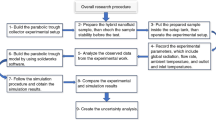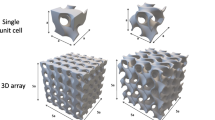Abstract
A grooved heat pipe (GHP) is an important device for managing heat in space applications such as satellites and space stations, as it works efficiently in the absence of gravity. Apart from the above application, axial GHPs are used in many applications, such as electronic cooling units for temperature control and permafrost cooling. Improving the performance of GHPs is essential for better cooling and thermal management. In the present study, the effect of anodization on the heat transfer characteristics of a GHP is studied with R600a as a working fluid. In addition, the effects of fill ratio, inclination angle and heat inputs on the heat transfer performance of a GHP are studied. Furthermore, the effect of heat flux on dimensional numbers, such as the Webber, Bond, Kutateladze and condensation numbers, are studied. The inclination angle, heat input and fill ratio of GHPs are varied in the range of 0°–90°, 25–250 W and 10–70 % respectively. It is found that the above parameters have a significant effect on the performance of a GHP. Due to the anodisation, the maximum enhancement in heat transfer coefficient at the evaporator is 39 % for a 90° inclination at a heat flux of 11 kW/m2. The reported performance enhancement of a GHP may be due to the large numbers of nucleation sites created by the anodisation process and enhancement in the capillary force due to the coating.










Similar content being viewed by others
Abbreviations
- \(Bo\) :
-
Bond number \(\left( {D\left[ {g\frac{{\rho_{l} - \rho_{v} }}{\sigma }} \right]^{{\frac{1}{2}}} } \right)\)
- \(c_{p,l}\) :
-
Specific heat of coolant fluid (J/kg K)
- \(Co\) :
-
Condensation number \(\left( {\frac{h}{k}\left[ {\frac{{\mu^{2} }}{{g\rho^{2} }}} \right]^{{\frac{1}{3}}} } \right)\)
- D:
-
Diameter (m)
- h :
-
Heat transfer coefficient (W/m2 K)
- I :
-
Current (A)
- T :
-
Temperature (°C)
- k :
-
Thermal conductivity (W/m K)
- l :
-
Length (m)
- \(\dot{m}_{l}\) :
-
Mass flow rate of coolant (kg/s)
- \(Ku\) :
-
Kutateladze number \(\left[ {\frac{q}{{\left[ {\rho_{v} h_{fg} \left( {\frac{{\rho_{l} - \rho_{v} }}{{\rho_{v}^{2} }}} \right)} \right]^{{\frac{1}{4}}} }}} \right]\)
- Q :
-
Heat transfer rate (W)
- q :
-
Heat flux (W/m2)
- R :
-
Resistance (°C/W)
- r :
-
Radius (m)
- V :
-
Voltage (V)
- W :
-
Width of groove (m)
- \(We\) :
-
Webber number \(\left( {\frac{{Q^{2} }}{{\rho_{v} D^{3} h_{fg}^{2} \sigma }}} \right)\)
- \(\sigma\) :
-
Surface tension (N/m)
- \(\theta\) :
-
Contact angle
- \(\rho\) :
-
Density (kg/m3)
- \(\mu\) :
-
Viscosity (Ns/m2)
- hp :
-
Heat pipe
- out :
-
Outlet
- in :
-
Inlet, input
- e :
-
Evaporator
- c :
-
Condenser
- e,i :
-
Evaporator inner wall
- c,i :
-
Condenser inner wall
- sat :
-
Saturation
- o :
-
Outer
- T :
-
Total
- l :
-
Liquid
- v:
-
Vapor
References
Shukla KN, Solomon AB, Pillai BC, Ibrahim M (2010) Thermal performance of cylindrical heat pipe using nanofluids. J Thermophys Heat Transf 24:796–802
Wang G-S, Song B, Liu Z-H (2010) Operation characteristics of cylindrical miniature grooved heat pipe using aqueous CuO nanofluids. Exp Thermal Fluid Sci 34:1415–1421
Liu Z-H, Li Y-Y, Bao R (2010) Thermal performance of inclined grooved heat pipes using nanofluids. Int Thermal Sci 49:1680–1687
Kumar RS, Vaidyanathan S, Sivaraman B (2015) Effect of copper nanofluid in aqueous solution of long chain alcohols in the performance of heat pipes. Heat Mass Transf 51:181–193
Nazarimanesh M, Yousefi T, Ashjaee M (2015) Experimental investigation on the effect of nanofluid on the thermal performance of symmetric sintered U shaped heat pipe. doi:10.1007/s00231-015-1644-x
Liu Z-H, Li Y-Y, Bao R (2011) Compositive effect of nanoparticle parameter on thermal performance of cylindrical micro-grooved heat pipe using nanofluids. Int J Thermal Sci 50:558–568
Abo El-Nasr A, El-Haggar SM (1996) Effective thermal conductivity of heat pipes. Heat Mass Transf 32:97–101
Solomon AB, Ramachandran K, Pillai BC (2012) Thermal performance of a heat pipe with nanoparticles coated wick. Appl Therm Eng 36:106–112
Hopkins R, Faghri A, Khrustalev D (1999) Flat miniature heat pipes with micro capillary grooves. J Heat Transf 121:102–109
Li Y, He H-F, Zeng Z-X (2013) Evaporation and condensation heat transfer in a heat pipe with a sintered-grooved composite wick. Appl Therm Eng 50:342–351
Wang C, Liu Z, Zhang G, Zhang M (2013) Experimental investigations of flat plate heat pipes with interlaced narrow grooves or channels as capillary structure. Exp Thermal Fluid Sci 48:222–229
Wong S-C, Chen C-W (2013) Visualisation experiments for groove-wicked flat-plate heat pipes with various working fluids and powder-groove evaporator. Int J Heat Mass Transf 66:396–403
Hu Y, Cheng J, Zhang W, Shirakashi R, Wang S (2013) Thermal performance enhancement of grooved heat pipes with inner surface treatment. Int J Heat Mass Transf 67:416–419
Lin F-C, Liu B-H, Juan C-C, Chen Y-M (2011) Effect of pore size distribution in bidisperse wick on heat transfer in a loop heat pipe. Heat Mass Transf 47:933–940
Wu SC, Hsieh BH, Wang D, Chen YM (2015) Manufacture of a biporous nickel wick and its effect on LHP heat transfer performance enhancement. Heat Mass Transf 51:1549–1558
Li X, Li M, Wu R, Wan Y, Cheng T (2015) Forming method of micro heat pipe with compound structure of sintered wick on grooved substrate. Heat Mass Transf. doi:10.1007/s00231-015-1585-4
Vasiliev L, Grakovich L, Rabetsky M, Romanenkov V, Vasiliev L, Ayel V, Bertin Y, Romestant C, Hugon J (2010) Grooved heat pipes with nanoporous deposit in an evaporator. Heat Pipe Sci Technol 1:219–236
Faghri A (1995) Heat pipe science and technology. Taylor and Francis, London
Solomon AB, Mathew A, Ramachandran K, Pillai BC, Karthikeyan VK (2013) Thermal performance of anodised two phase closed thermosyphon (TPCT). Exp Thermal Fluid Sci 48:49–57
Solomon AB, Roshan R, Vincent W, Karthikeyan VK, Asirvatham LG (2015) Heat transfer performance of an anodized two-phase closed thermosyphon with refrigerant as working fluid. Int J Heat Mass Transf 82:521–529
Holmon JP (2011) Experimental methods for engineers, 8th edn. McGraw-Hill, New York
Huminic G, Huminic A (2011) Heat transfer characteristics of a two-phase closed thermosyphons using nanofluids. Exp Thermal Fluid Sci 35:550–557
Lienhard JH IV, Lienhard VJH (2003) A heat transfer text book, 3rd edn. Phlogiston Press, Cambridge, p 21
ASHRAE Hand Book: Fundamentals (2009) Chapter 30-Thermophysical properties of refrigerants. EBSCO Publishers, USA, pp 30–49
Acknowledgments
The authors appreciate the technical assistance of Mr Jeyaseelan of the Centre for Research in Material Science and Thermal Management, Karunya University, during fabrication and testing.
Author information
Authors and Affiliations
Corresponding author
Rights and permissions
About this article
Cite this article
Solomon, A.B., Ram Kumar, A.M., Ramachandran, K. et al. Characterisation of a grooved heat pipe with an anodised surface. Heat Mass Transfer 53, 753–763 (2017). https://doi.org/10.1007/s00231-016-1856-8
Received:
Accepted:
Published:
Issue Date:
DOI: https://doi.org/10.1007/s00231-016-1856-8




